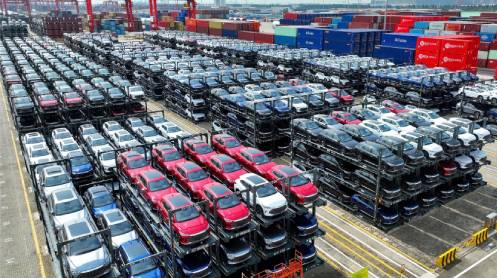Pakistan is currently in the midst of political upheaval and economic uncertainties. It may appear odd that anyone would be interested at this juncture in reading about the long-term development path of the country.
However, it must be emphatically submitted that in our pursuit of immediate and short-term relief and gratification we have been pursuing a band aid fix-it-now approach postponing and neglecting the serious deep-rooted structural problems that are indeed the main cause of our secular economic decline and frequent economic crises. It is a clarion call for our leaders and policymakers to think for a moment about the damage to this country if we continue to remain embroiled in political point scoring, adversarial relationships and polarizing society. As time passes, the difficulties and challenges will become compounded, governance will become more complex and entangled and no party in power would be able to find amicable solutions.
The coming decades would be characterized by technological advances that can prove to be an opportunity for our economic turn-around, provided we begin to take the first steps on this long and arduous journey. This article is an attempt to throw some light as to how we can take advantage of this opportunity, failing which we would further descend down the ladder in the comity of nations while others overtake us just like we have witnessed in the last 30 years.
It is now increasingly clear that the determinants of long-term sustained economic growth in the next decades of the 21st century will be innovation and technological diffusion mediated through human capital and skilled workforce. No longer is the quest for oil and gas discoveries or mining bonanza such as gold, diamond, platinum etc likely to make any perceptible difference in the living standards of the ordinary citizens, although they may generate windfall gains for the narrow elite class. Yes, in the short-term returns from physical or natural capital will continue to dominate but countries have to sooner than later start preparing themselves for the transition and subsequent investment in developing the capabilities and the ecosystem for the new competitive world. Those who are wishing away globalization and economic linkages do not realize the inevitability of technological advances sweeping away the barriers artificially constructed in the name of geopolitical power games.
Whether we call it knowledge economy, label it the Fourth Industrial Revolution, spread of frontier technologies or spurt of creative industries, the driver behind all these phenomena is the growing demand for a different skill set for the workforce. The US Department of Labour has projected that 65 percent of today’s schoolchildren will eventually be employed in jobs that have yet to be invented. Advances in Artificial Intelligence, machine learning and data analytics are changing the way knowledge is organized and are already making routine, repetitive, low-tech, jobs redundant as mass scale produced labour-intensive products in global markets are on a gradual declining path.
Platform economies with online sales or technology frameworks and transaction platforms – digital matchmakers or the gig economy – are making inroads. A survey by the World Economic Forum in 2020 found out that data entry clerks, administrative and executive secretaries, management and organizational analysts and middle-level managers, sales workers, news and street vendors, assembly and factory workers, accountants and auditors, legal secretaries, etc have become or are in the process of becoming superfluous. There would instead be growing demand for AI and machine-learning specialists, digital transformation specialists, digital marketing and strategy specialists, data analysts and scientists, Big Data specialists, etc. Automation and digitalization of business processes in the government and private sector will reinforce these needs.
The growing importance of creative industries based on intellectual contribution has led to a revisit of the traditional Science, Technology, Engineering and Mathematics (STEM) to add arts such as advertising, architecture, designing, fashion, TV, videos and film, music, photography, publishing, performing arts to develop a new concept of STEAM – Science, Technology, Engineering, Arts and Mathematics. Secure property rights, openness to trade and investment, fast internet connectivity, declining cost of communication and ease of doing trade in services across borders have made STEAM the major driver of growth. This can be illustrated by the spectacular record of China which graduates five million in STEM subjects every year, produces 50,000 PhDs in these subjects (compared to 34000 in the US) and has the highest number of graduate students in the top science and engineering departments in the leading universities of the US. Until the year 2000, the US was way ahead of China in the annual output of STEM PhDs (the data on full complement of STEAM is not yet available although Korea’s BTS and India’s Bollywood have become well known).
In Pakistan, the early years of the 1950s and 1960s universities and colleges had relatively more students enrolled in science subjects and most faculty members had doctorate degrees from Ivy League schools or London, Oxford and Cambridge. I distinctly remember that my alma mater, the University of Sindh located in Hyderabad, had a number of young and highly committed faculty members in Physics, Chemistry, Mathematics, Zoology, Geology, Botany who had returned after obtaining their PhD degrees from top universities across the world.
Fifty years later, the student enrolment pattern has shifted from Science to Commerce, Business Studies, Islamic studies, local languages etc and the graduate unemployment rates are among the highest ever recorded. Subjects such as the sciences or mathematics and IT fall short of the demand. Only 25,000 students graduate every year in IT-related subjects while we need at least 100,000 to meet the growing demand. Science and Math teacher vacancies remain unfilled in our schools and colleges. To attract students towards STEAM subjects, liberal scholarships should be granted to talented students to pursue degree and graduate studies with particular emphasis on female students. Only a handful of present faculty members in our science departments have been trained at top foreign universities and local institutions such as Quaid-e-Azam University, LUMS, NUST, GIK or others in the same category.
There has been a proliferation of universities; the number exceeds 220 which is commendable in terms of access to tertiary education. However, higher educational institutions are not known for their brick-and-mortar structures or for creating incentives for the faculty to grab powerful administrative positions with the associated monetary and in-kind benefits or for indulgence in plagiarism to add to the list of publications. The performance indicators are not how many new departments or institutes, or centers have been created but what has been the relevance of their work and contribution in generation, dissemination and application of knowledge to the multitude of social and economic problems faced by the country.
Echoes of industry-academia collaboration resonate loudly but how many science or technology parks have been established where industrial units are located. How many agriculture universities have developed new varieties, techniques, practices, scaled them up and transferred to the farmers in their respective districts where they are located. The majority of the faculty have degrees from less well-known foreign universities and not so reputable local institutions and are far from the cutting edge in their respective fields.
We are swimming against the current, which is the pursuit of excellence. The HEC, Fulbright and other scholarship programmes should be geared to send young faculty and scholars to top universities in the US, UK, Canada, Australia and Germany for doctorate degrees, post-graduate fellowships, and visiting scholar programmes in STEAM subjects.







